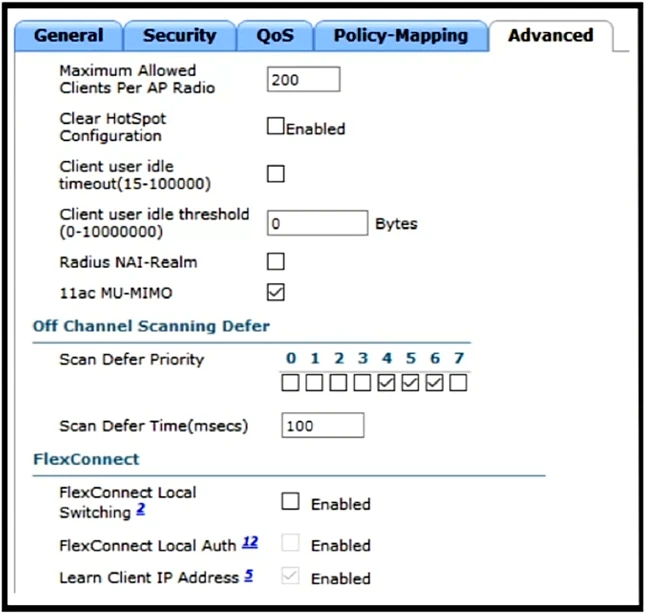The correct CLI command to add a VLAN with VLAN ID of 30 to a FlexConnect group named BranchA-FCG on a Cisco WLC is 'config flexconnect group BranchA-FCG vlan add 30'. This command syntax specifies the group name, action, and VLAN ID correctly.

Refer to the exhibit. A customer has implemented Cisco FlexConnect deployments with different WLANs around the globe and is opening a new branch in a different location. The engineer's task is to execute all the wireless configuration and to suggest how to configure the switch ports for new APs. Which configuration must the switching team use on the switch port?
In a Cisco FlexConnect deployment, configuring the switch port correctly is crucial. When FlexConnect Local Switching is enabled, the AP can handle traffic locally without sending it back to the controller, which would necessitate trunk mode to allow multiple VLANs on a single port. Even though the current configuration does not have FlexConnect Local Switching enabled, it is generally recommended to configure the switch ports for APs in FlexConnect mode as trunk ports. This ensures that as different WLANs are configured or as requirements change, the switch can accommodate multiple VLANs, supporting the full flexibility and scalability of the deployment.
FlexConnect mode with local authentication allows the access points to authenticate clients locally, rather than sending authentication requests to the central wireless LAN controller (WLC). This reduces the traffic between the APs and the WLC, which is crucial for minimizing delays and ensuring strong connectivity in a network that spans across different countries using MPLS. This configuration is optimal for minimizing the amount of traffic traversing the network backbone.
Split tunneling is the correct configuration on the Cisco WLC to allow the user to access local resources like a printer on their home network. Split tunneling allows traffic to be divided between the corporate network and local network resources, enabling the user to print to their home printer while connected to the corporate network through the OfficeExtend AP.
To configure a Cisco WLC to support Cisco Aironet 600 Series OfficeExtend APs, the supported Layer 2 security options include WPA+WPA2, which ensures robust security through Wi-Fi Protected Access protocols, and 802.1X, which provides network access control through an authentication server. Static WEP and CKIP are outdated and less secure, making them unsuitable for modern WLAN security standards.